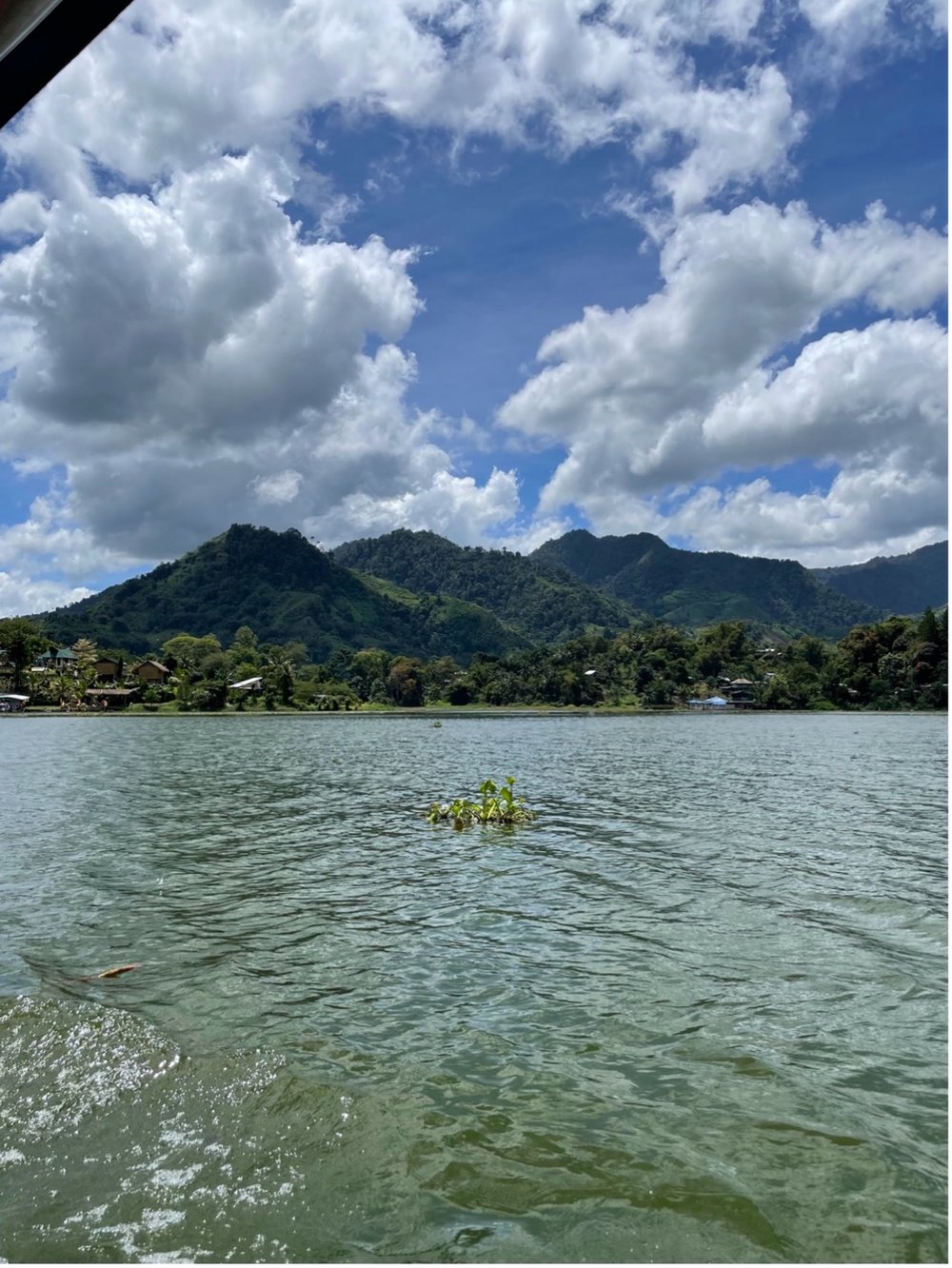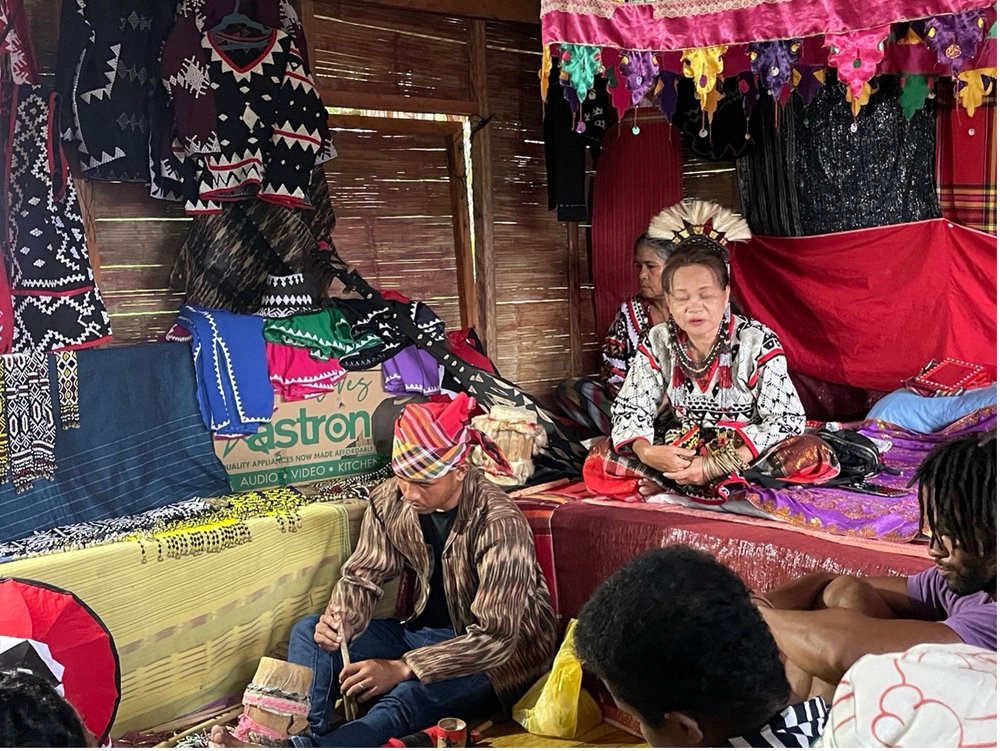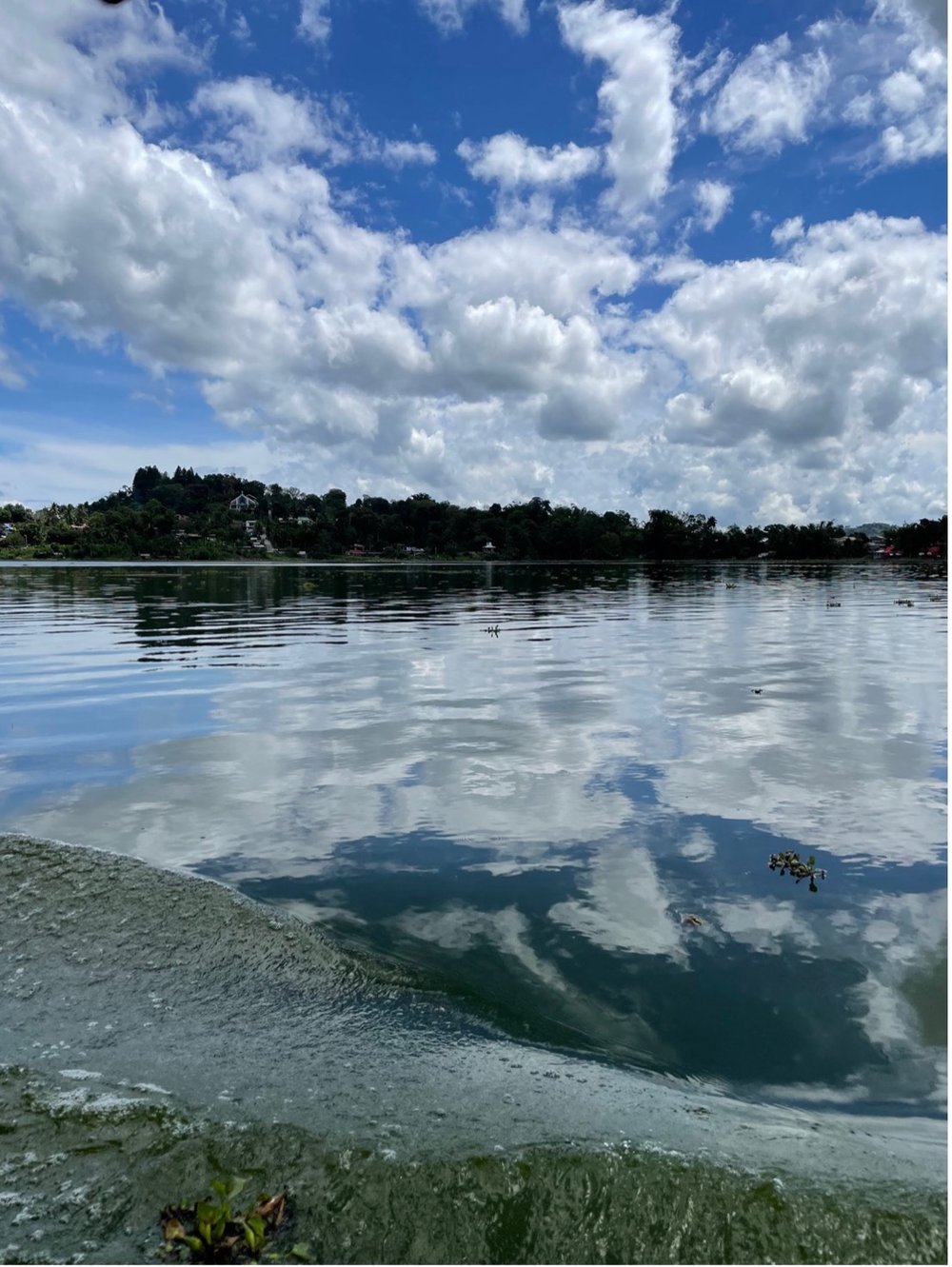Memories of Mindanao: A Lake in the Sky
From 2/17/23 to 3/4/23 I participated in TribuTur, a “hands on field study custom-designed for participants to explore, discover, and draw empowerment from indigenous Filipino cultures of Mindanao.” The tour is conducted by the venerable SF arts organization Kularts and its visionary artistic director, Alleluia Panis. The following snippets are from the third leg of the journey after Cotabato. All of these stories are derived from daily letters to my spouse, Catherine, chronicling this unforgettable experience.

Lake in the sky (Photo by Conrad Benedicto)
We came to the shores of Lake Sebu via an exhilarating but concerning habal-habal ride down to the lake. A habal-habal is a motorcycle with an extended back seat designed to let two passengers ride behind the driver. I partnered with Gabrielle to be the passengers of Ronald who motored into the parking lot of our mountain inn with an entire posse of riders wearing racing gear instead of chaps and bandanas and cowboy hats. No helmets, if you please.

The dreaded habal-habal ride (Photo by Conrad Benedicto)
When we arrived at the lakeside, we were greeted by the tell-tale signs of resorts and souvenir shops. Beyond the gauntlet of stalls, a tour boat awaited us down a steep staircase trail. When we got on the vessel, an elder named Auntie Myrna was waiting to accompany us along with a handful of other culture bearers. Auntie Myrna told stories and sang songs about the lake while her companions played the hegalong (boat lute) and t’nonggong (deer skin drum) as our boat drifted along. She sang of the long-haired woman who discovered the waters of Lake Sebu and of the husband who tried to save her. She told stories of the T’boli people sharing the lake and how in her childhood her father would come down to its shores in the morning and head back up the mountain at the end of the day with fish for his family. She spoke of the old days, when disputes could be settled by tribal law. The longing in Auntie Myrna’s voice slowly grew until she could no longer keep her tears.

Auntie Myrna is smiling second from right (Photo by Conrad Benedicto)
Lake Sebu is in the lands of the T’boli people but sadly in the hands of developers. When a T’boli person has a dispute with a developer, they must hire a lawyer that they cannot afford. Now landless, many of the people became poor and like poor people everywhere, they run into the law, which is no longer tribal law but property law that wrongs them. Auntie Myrna’s stories contrasted starkly with the Bangsamoro who, although faced with conflict still, did not sell theirs from such a disadvantaged position.
Besieged by development, Lake Sebu’s ecosystem has also lost its autonomy. Its waters have become too eutrophic, so thick with frills of algae in some spots that it seems unlikely any oxygen is left for fish. Still, there are egrets prancing along the shores and, in the more remote ends of the lake, the wooden dwellings of common folk, which unlike the resorts have roots in the silt, persist. Still, the surrounding peaks encircle the lake in a lush arboreal embrace.
That morning Tribu participants prepared offerings for Lake Sebu. Some made beautiful arrangements of orchids and bougainvillea nestled inside woven blades of iris. I placed a tiny handful of rice and a lock of hair inside the not so pretty pouch I had constructed. Once we reached the middle of the lake, we carefully placed the offerings in the water and watched them drift away between the lotus leaves and onto the realm of Bawulan, who created the lake by collecting water using the long strands of her own tresses. Swallows flew above our boat as if to guide them.
—000—
In the afternoon we got back on our habal-habals and vroomed along a mountain road until it became a dirt lane and then a muddy trail. Instead of horses, a herd of motorcycles conveyed us into the heart of the forest where sits the Gono Lmingon, or Chanter’s House, the home of a renowned T’boli chanter whose English name is Rosie.

Auntie Rosie in the Chanter’s House
In a small but beautiful space with thatched windows that opened up to the misty mountainside, Rosie received us with cups of delicious coffee, steamed sweet bananas, and rice cakes. Hanging on the walls of the room and lying on her bed were many beautiful woven t'nalak fabrics of the famous T’boli dream weavers, colorful bead necklaces, tinkling brass bracelets and anklets, and musical instruments. The pleasantries were delightful and soon many of the items on display were inside the backpacks and purses of the turistas. At last, it was time for Rosie to sing. If I had been a swallow flying overhead, I surely would have stopped to perch myself on a tree branch just to hear the mournful voice resonating from this tiny home amidst the trees. Indeed, it felt as if the whole forest was leaning silently toward the Chanter’s House as Rosie sang.
Like Auntie Myrna, Rosie is burdened with the troubles native people encounter when they are encroached upon by foreigners who have the law and armed government on their side. We could have been sitting inside a roundhouse in California during the Gold Rush or a Sundance ceremony on the Great Plains of America after the Civil War. Rosie’s songs and troubles were the same. But so was the persistence of culture and memory. Six children came to the house after their dismissal from school and shared the songs and dances Rosie taught them. Their voices were hopeful and happy. There was also a young man who played the mouth harp, flute, and kulintang like a budding master artist. Inside the Gono Lmingon’s cozy little room, traditions lived on, and the land grabbers were far away. Here, some lasting beauty of T’boli culture was sustained as if by an enchantment woven from Rosie’s songs.
—000—
We left the Chanter’s House with full bellies, riding through the forest behind our motored cowboys, bouncing up and down on the rocks and ruts of the muddy trail. A strong drizzle turned up my anxiety as we re-emerged onto the now slick concrete. However, Ronald conveyed us with expert skill and we were soon at our next destination--a community school led by another woman whose English name is Maria.

At Auntie Maria’s Community School (Photo by Conrad Benedicto)
Maria’s school is also inside a gonong, which is an upraised dwelling. The smooth ground underneath this structure functioned as the kitchen and dining area while the top floor served as the classroom/recital hall. We were received in the dining area first where another sumptuous feast awaited even though we had eaten at Rosie’s not two hours ago. I was greatly surprised by what I saw as I was taking my seat. On the wall, here in the mountains of Mindanao, was a banner featuring the Medicine Wheel. An elder by the name of Eagle Sun, may he rest in peace, taught me the Medicine Wheel so that I may teach it to my students in the Wilderness Arts and Literacy Collaborative (WALC). It was inspiring to see that thousands of miles from Turtle Island, Maria was using the Medicine Wheel too.
The similarities between indigenous peoples in the U.S. and the Philippines had been hitting me all day. The T’boli of Lake Sebu are going through a dispossession similar to the one the Washoe of Lake Tahoe experienced 170 years ago. The issue of over-eutrophication is also a parallel. The T’boli dances here are so similar to the prayers I have witnessed in the roundhouse at Chaw’se back in the Sierra foothills of California. They even have a monkey dance which serves the same comical teaching purpose as a special coyote dance that I once saw, when WALC was first invited to the Big Time celebration at Chaw’se. That poster was proof that indigenous people around the world communicate, commiserate, and share wisdom and inspiration with each other.
The unity of nature, art, and tradition is the cornerstone of Maria’s program and the success of it was very evident in the teenagers who performed the songs and dances. It was heartening to see T’boli teenagers, not just little children, taking up the sacred work of culture-bearing. Again, what we witnessed were budding master artists able to mimic horse trotting rhythms on the drum and add complex interlocking counterpoints on the small agong and thick bamboo. Of course, there was also the kulintang, which in the mountains, has an entirely different melodic persona.

T’Boli culture lives on (Photo by Conrad Benedicto)
—000—
The roar of two-stroke engines announced the coming of the habal-habal posse. Around the bend of the mountain road, the single yellow headlights peered through the pouring rain. The prospect of riding on a motorcycle with two other people in the dark, during a downpour back to our resort was, well, terrifying. All I could think of was how to possibly dismount and somehow skid on my backpack without hitting my head on the concrete road if Ronald ever lost his grip as we rounded yet another slick corner, or revved up an upcoming incline at twice the speed. Gabrielle and I were very talkative on the previous legs of this habal-habal journey, but our mouths were shut this time. The only communication between us were my fingers digging into his shoulders. We had also ziplined across a several thousand feet deep ravine the previous day. That was nothing compared to the terror of this last motorcycle ride. Finally, Ronald put his boot down on the muddy parking lot of our resort to steady us and I breathed a sigh of relief. I gave that man a big tip.
Is there anything more magical than a lake in the sky? Near the Daguma and Talahik mountains there is such a lake. Its waters were collected within the sinuous dark of a mythical woman’s hair. Its lore is preserved by a powerful circle of women’s voices. In the woods and valleys that surround it riders guide their iron horses through the night rain. One day when you come upon it at the turn of a mountain road and it appears before you as it once did, emerging from the mists of time, may its people be free.

Mirroring the clouds (Photo by Conrad Benedicto)

Conrad Benedicto is a teacher, author, and musician. His fantasy novel, Musalaya’s Gift, was published by Kularts in 2021 and the music of his band, Kulintang Dialect, is available on all streaming platforms courtesy of Gongs Away Music.
More articles from Conrad Benedicto






No comments:
Post a Comment